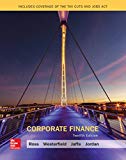
a.
Adequate information:
Salvage value = $150,000
Cost of equipment (C) = $2,100,000
Fixed cost (FC) = $650,000
Net working capital (NWC) = $325,000
Price per unit = $20
Variable cost per unit (V) = $9.45
Useful life of equipment = 5 years
Sales units (Q) = 145,000
Tax rate (T) = 21% or 0.21
Required
To compute:
- The
net present value (NPV) of the project. - The net present value (NPV) of the project, if the bid price has been changed.
- The net present value (NPV) of the project, if the number of cartons sold changes.
- The net present value (NPV) of the project, if the cost of the cartons changes.
Introduction: Net present value is defined as the summation of the present value of
b.
Adequate information:
Salvage value = $150,000
Cost of equipment (C) = $2,100,000
Fixed cost (FC) = $650,000
Net working capital (NWC) = $325,000
Price per unit = $20
Variable cost per unit (V) = $9.45
Useful life of equipment = 5 years
Tax rate (T) = 21% or 0.21
Required rate of return (r) = 11% or 0.11
To compute: The quantity of cartons per year if it is a breakeven scenario
Introduction: The decision criteria of net
c.
Adequate information:
Salvage value = $150,000
Cost of equipment (C) = $2,100,000
Net working capital (NWC) = $325,000
Price per unit = $20
Variable cost per unit (V) = $9.45
Useful life of equipment = 5 years
Sales units (Q) = 145,000
Tax rate (T) = 21% or 0.21
Required rate of return (r) = 11% or 0.11
To compute: Fixed costs
Introduction: Total fixed costs do not change with the change in activity base or unit. In the other words, it remains the same at all levels of production. For instance, rent, interest on loans, depreciation, and so on. These costs have to be paid whether production occurs or not.
Want to see the full answer?
Check out a sample textbook solution
Chapter 6 Solutions
Loose Leaf for Corporate Finance Format: Loose-leaf
- On May 3, 2020, Leven Corporation negotiated a short-term loan of $840,000. The loan is due October 1, 2020, and carries a 6.60% interest rate. Use ordinary interest to calculate the interest. What is the total amount Leven would pay on the maturity date? (Use Days in a year table.)arrow_forwardNolan Walker decided to buy a used snowmobile since his credit union was offering such low interest rates. He borrowed $4,300 at 3.75% on December 26, 2021, and paid it off February 21, 2023. How much did he pay in interest? (Assume ordinary interest and no leap year.) (Use Days in a year table.)arrow_forwardAnswer finance problem with correct given values do not assume any values. and no chatgptarrow_forward
- this is finance probarrow_forwardFinance prarrow_forwardWhat is a problem statement outline? Could you please give seome examples? What are the research questions and methodology? How do they work, please some examples? What is a research framework outline? Please give some examples. What is a Final Research Concept? Please give some example.arrow_forward
- Skip Stephens is trying to decide whether it would be wise to consolidate his debt by borrowing funds from Syndicated Lending, a firm that he doesn’t know much about. Syndicated is an Internet lender that doesn’t post much information about the costs of the loans it offers. Some of the additional information Skip has gathered from various sources suggests the Syndicated might use such unethical practices as “bait and switch” to attract customers. Discussion questions: Is there an ethical problem? If so, what is it? What are the implications if Skip borrows from Syndicated? Should Skip borrow from Syndicated?arrow_forward9-15arrow_forward9-16arrow_forward
 Essentials of Business Analytics (MindTap Course ...StatisticsISBN:9781305627734Author:Jeffrey D. Camm, James J. Cochran, Michael J. Fry, Jeffrey W. Ohlmann, David R. AndersonPublisher:Cengage Learning
Essentials of Business Analytics (MindTap Course ...StatisticsISBN:9781305627734Author:Jeffrey D. Camm, James J. Cochran, Michael J. Fry, Jeffrey W. Ohlmann, David R. AndersonPublisher:Cengage Learning
